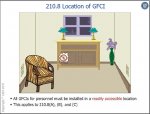jxofaltrds
Retired ESI
- Location
- Mike P. Columbus Ohio
- Occupation
- Creator
210.8 Ground-Fault Circuit-Interrupter Protection for
Personnel. Ground-fault circuit-interruption for personnel
shall be provided as required in 210.8(A) through (C). The
ground-fault circuit-interrupter shall be installed in a
readily accessible location.

Sounds like the GFCI is not allowed behind the frig?
Personnel. Ground-fault circuit-interruption for personnel
shall be provided as required in 210.8(A) through (C). The
ground-fault circuit-interrupter shall be installed in a
readily accessible location.

Sounds like the GFCI is not allowed behind the frig?


